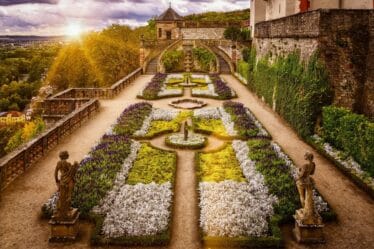

Florence’s Forgotten Street Kings and Their Festive Reigns
A City of Rival Monarchs
In 16th and 17th-century Florence, several groups of commoners, known as “Potenze” (Powers), played a key role in organizing festivals, parades, dances, masquerades, and feasts across different neighborhoods. These organizations were similar to today’s festival committees, each electing a leader with grand titles like “King” or “Emperor” to manage their activities.
One of the most famous mentions appears in the Tabernacle of the Fonticine on Via Nazionale, where an inscription reads:
“This devout tabernacle was commissioned by the men of the Kingdom of Beliemme, located on Via Santa Caterina, in the year 1522.”
The Legendary Leaders of Florence’s “Potenze”
Each neighborhood had its own ruler, often named after local symbols. Some of the most renowned included:
- Emperor of Prato (Porta al Prato)
- King of the Gatta (San Pier Gattolino area)
- Grand Master of the Swallows (San Piero)
- King of the Rooster (Porta San Gallo)
- Count of the Mota (Via dei Renai)
- Duke of Chaos (Piazza Peruzzi)
- Marquis of the Net (Via Gora)
- Prince of Wealth (Mercato Vecchio)
- Duke of the Small Bowl (San Simone)
- Captain of the Apple (Canto della Mela)
- Duke of the Sheep (San Martino)
- King of the Sheaf (Canto della Paglia)
- Archduke of Monteloro (Canto di Monteloro)
- Lord of the Graticola (San Lorenzo)
- Duke of the Gutters (Piazza del Duomo)
- Lord of the Whip (San Felice in Piazza)
- King of the Wool Workers (Orsanmichele)
- Duke of the Moon (Via Strozzi)
- Duke of the Carroccio (Mercato Nuovo)
- King of Gold (Borgo San Niccolò)
- Lord of the Leather (Ponte alla Carraia)
- Duke of the Cow (San Leo)
- Grand Master of the Red City (San Ambrogio)
A Legacy in Stone: The Lasting Marks of the Potenze
Some of these forgotten rulers still leave traces in Florence’s streets. In San Ambrogio, a marble plaque at the corner of the church features a crowned emblem with the initials ACAI and GM.GM, alongside the date 1577. Below it, another inscription reads “Città Rossa” (Red City), possibly referring to the area’s brick construction or the nearby Via della Mattonaia, historically known for its brick kilns.
The Role of the Potenze: Beyond Festivals
While primarily festive groups, the Potenze also financed and built chapels, tabernacles, and public works in their neighborhoods. They operated with a structured hierarchy, similar to a royal court, including:
- Provveditori (Administrators)
- Camerlengo (Treasurer)
- Captains and Field Masters (Military roles)
- Standard Bearers (Flag and emblem keepers)
With 100–200 members, these groups were small, organized citizen militias, often competing against each other. Their rivalries sometimes led to street battles, forcing authorities to outlaw them.
A marble plaque in Santa Lucia sul Prato reads:
“Imperator ego vici proeliando lapidus – Year of the Lord 1594”, likely referencing a violent event in the area.
The End of the Potenze: A Threat to the Medici Rule
By 1629, under Grand Duke Ferdinando II de’ Medici, the Potenze were permanently banned due to the unrest they caused. Historian Emilio Gabrielli Bacciotti wrote:
“The Medici feared these riotous gatherings, always ready to spark an uprising…”
A final inscription at Borgo Pinti and Via dei Pilastri reads “Timor Dominy 1473”, likely linked to the Archduke of Monteloro, with a second inscription below simply stating “Fine” (The End).



